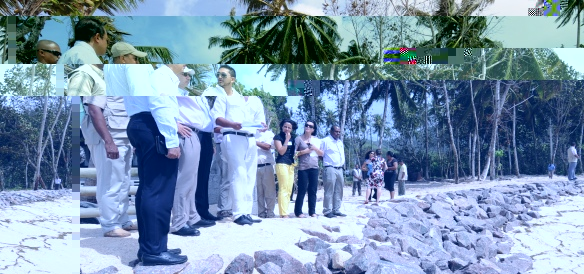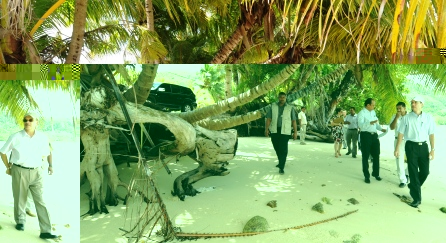President Michel visits areas hit by coastal erosion in south and west Mahe-Residents urged to share ownership of our coastal areas |16 September 2011

The President made the appeal yesterday after visiting several districts in south and west Mahé to view areas hit by coastal erosion and projects being carried out to rehabilitate these sites.
On his visit to Anse Royale, Anse à la Mouche, Anse Boileau and the Biodiversity Centre at Barbarons the Head of State was accompanied by the Minister responsible for Environment, Joel Morgan, and his principal secretary Didier Dogley, the presidential advisor for environmental affairs, Dr Rolph Payet, and senior State House officials.
The first stop was at Anse Royale, where the President and his delegation were joined by the chief executive of the Seychelles Tourism Board (STB) Alain St Ange.
They inspected the beachfront site where a beach leisure park is being set up.
It was suggested that there is need for the park to be self-supporting, with a cafeteria and other public amenities, though there are several shops within walking distance.
The beach is already a favourite picnic spot for residents and it is hoped that the new developments will add to its attractions.
Coastal erosion is not acute at Anse Royale and in most spots, the beach is being quite well protected by rock armouring . The rock beaching differs from conventional armouring in that its angle of repose is gentle so as to dissipate wave energy.
The next stop was Anse à la Mouche, on Mahé’s west coast. This is where the President grew up and he said he was shocked by the gravity of coastal erosion there. On site, he noted that driving by, one does not know that the problem is so acute, until one goes on the beach.
There, coconut palms and takamaka trees hang precariously over the beach, while some trees already uprooted, stick out grotesquely.
The President recalled some huge takamaka trees under which he used to play as a boy, but now presumably long gone.
From Anse à la Mouche beach, an ugly scar in the mountainside is something nobody can miss.
Environment officials said such development using heavy earth-moving equipment has been carried out without planning permission. The owner has been served with a notice not to proceed.
President Michel told the press later that the accelerated beach erosion shows that climate change is a reality and is hitting us.
“That is why at every international conference I attend, I seek to attract the international community’s attention to the phenomenon, which is affecting our planet, but more especially small island states, like Seychelles, which are more vulnerable.”
Noting that sea level rise, brought by climate change, has been established at 6mm yearly, President Michel said the tour was an opportunity to assess the gravity of the situation.
But he said the government was already working to mitigate its repercussions.
Some feasibility studies have been carried out with expertise from the European Union, Japan and Cuba and Seychelles is also in negotiations to secure funds to assist in our conservation efforts.
He added that Seychelles has been actively lobbying international organisations concerned not only with the Indian Ocean, but also the Pacific and Caribbean.
President Michel noted that such efforts are particularly obvious at Anse Boileau, where work carried out by the Ministry of Environment with some foreign partners has yielded positive results.
Under a project funded by ReCoMap (Regional Programme for Sustainable Management of Coastal countries of the Indian Ocean), two-step timber piling is creating a barrier between coastal dunes and the surge attack. The piling follows the natural topography and contour of the beach to create natural pocket areas of up to 400 metres from the main roads.
But he said that most importantly, the population must realise the nature of the problem and not aggravate it.
President Michel said he is aware of other places, besides Mahé’s west coast, also hit by coastal erosion, including Praslin and La Digue.
Calling on all residents to share ownership of our coastal areas, President Michel said:
“Don’t just rely on government to do everything. Residents can all contribute their share towards such conservation efforts.
“By planting trees along the beachfront areas, we can help protect our beach and coastal sites.”
He praised the initiatives already taken by Environment and wildlife clubs operating under the aegis of the Ministry of Education, but added that more can still be done.
He recalls that when he was still a young boy, many youths used to go around with catapults killing birds in our forests.
“If this is no longer the case, it is because of the positive change brought about by education and environmental awareness,” he said.
“We must do everything we can to protect our environment for our own enjoyment and that of future generations,” the President added.
The Biodiversity Centre at Barbarons can also help a lot in such education, as it constitutes a shining example in environmental protection, the President noted.






